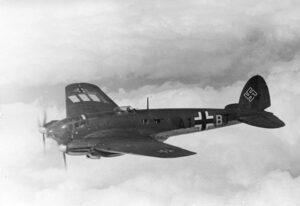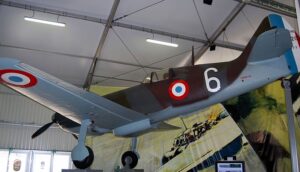Time Period: World War II
Country of Origin: Germany
Type: Bomber Aircraft, Reconnaissance and Surveillance
Manufacturer: Junkers
Junkers Ju 188 Aircraft Overview
The Junkers Ju 188 was a twin-engine medium bomber used by the Luftwaffe during World War II. Developed by the Junkers Flugzeug und Motorenwerke, the Ju 188 was designed as an advanced successor to the earlier Ju 88 bomber, incorporating improvements in performance, range, and payload capacity.
The Ju 188 featured a sleek and aerodynamic design, with a streamlined fuselage, low-mounted wings, and twin-engine nacelles. It was powered by two Junkers Jumo 213 inline engines, which provided the aircraft with impressive speed and altitude capabilities. The aircraft’s design also incorporated a pressurized cockpit, allowing for high-altitude operations and improved crew comfort.
With its heavy bomb load capacity and long-range capabilities, the Ju 188 was primarily used for tactical bombing missions, including attacks on enemy infrastructure, industrial targets, and military installations. It was also employed in reconnaissance roles, utilizing its speed and altitude performance to gather intelligence behind enemy lines.
The Ju 188 was armed with a variety of defensive armament, including machine guns mounted in dorsal, ventral, and tail positions to fend off enemy fighters during bombing runs. Additionally, it could carry a payload of bombs internally in its bomb bay, as well as externally on underwing racks for increased versatility in mission profiles.
Despite its advanced design and capabilities, the Ju 188 faced challenges during its operational service, including production delays, engine reliability issues, and vulnerability to enemy fighter interception. However, it saw action on both the Eastern and Western Fronts, where it conducted bombing raids and reconnaissance missions against Allied targets.
Junkers Ju 188E-1 Specifications
- Crew: 4
- Length: 14.95 m (49 ft 0.5 in)
- Wingspan: 22.00 m (72 ft 2 in)
- Height: 4.45 m (14 ft 7 in)
- Wing area: 56.0 m2 (602.7 sq ft)
- Empty weight: 9,990 kg (22,024 lb)
- Max takeoff weight: 15,195 kg (33,499 lb)
- Powerplant: 2 × BMW 801D-2 14-cylinder air-cooled radial piston engines, 1,300 kW (1,700 hp) each for take-off. 1,070 kW (1,440 hp) at 5,700 m (18,700 ft)
- Propellers: 3-bladed constant-speed propellers
Junkers Ju 188E-1 Performance
- Maximum speed: 500 km/h (310 mph, 270 kn) at 6,000 m (19,685 ft)
- Cruise speed: 375 km/h (233 mph, 202 kn) at 5,000 m (16,400 ft)
- Service ceiling: 9,350 m (30,665 ft) with 2,000 kg (4,400 lb)
- Time to altitude: 6,100 m (20,000 ft) in 17 minutes 42 seconds
- Wing loading: 258.9 kg/m2 (53.0 lb/sq ft)
- Power/mass: 0.175 kW/kg (0.106 hp/lb)
Junkers Ju 188E-1 Armament
- Guns: 1 × 20 mm (0.787 in) MG 151/20 cannon
- 3 × 13 mm (0.512 in) MG 131 machine guns
- Bombs: 3,000 kg (6,600 lb)
Junkers Ju 188 Image Gallery
More Junkers Aircraft

Junkers Ju 87 Stuka
The Junkers Ju 87 was a German Luftwaffe dive bomber and ground-attack aircraft first flown in 1935 and used during World War II.

Junkers Ju 88
The Junkers Ju 88 was a German Luftwaffe twin-engined multirole combat aircraft introduced in 1939 and used widely during World War II.

Junkers Ju 52 Tante Ju
The Junkers Ju 52 was a German transport aircraft designed by Junkers used as both an airliner and deployed during World War II.
More Luftwaffe Aircraft
The Luftwaffe, the German air force during World War II, fielded a diverse range of aircraft that played critical roles in the conflict. These aircraft encompassed fighters, bombers, reconnaissance planes, transport aircraft, and more. Explore others:

Focke-Wulf Fw 190
The Focke-Wulf Fw 190 was a German single-seat, single-engine fighter aircraft and the backbone of the Jagdwaffe of the Luftwaffe.

Messerschmitt Me 163 Komet
The Messerschmitt Me 163 Komet was a German rocket-powered interceptor aircraft primarily used by the Luftwaffe in the 1940s.

Focke-Wulf Ta 152
The Focke-Wulf Ta 152 was a World War II German high-altitude fighter-interceptor that entered service with the Luftwaffe in January 1945.

Messerschmitt Me 262 Schwalbe
The Messerschmitt Me 262 Schwalbe was a German fighter designed by Messerschmitt and used during the Second World War.

Heinkel He 111
The Heinkel He 111 was a German airliner and bomber described as a “wolf in sheep’s clothing” as it presented solely as a civil airliner.










